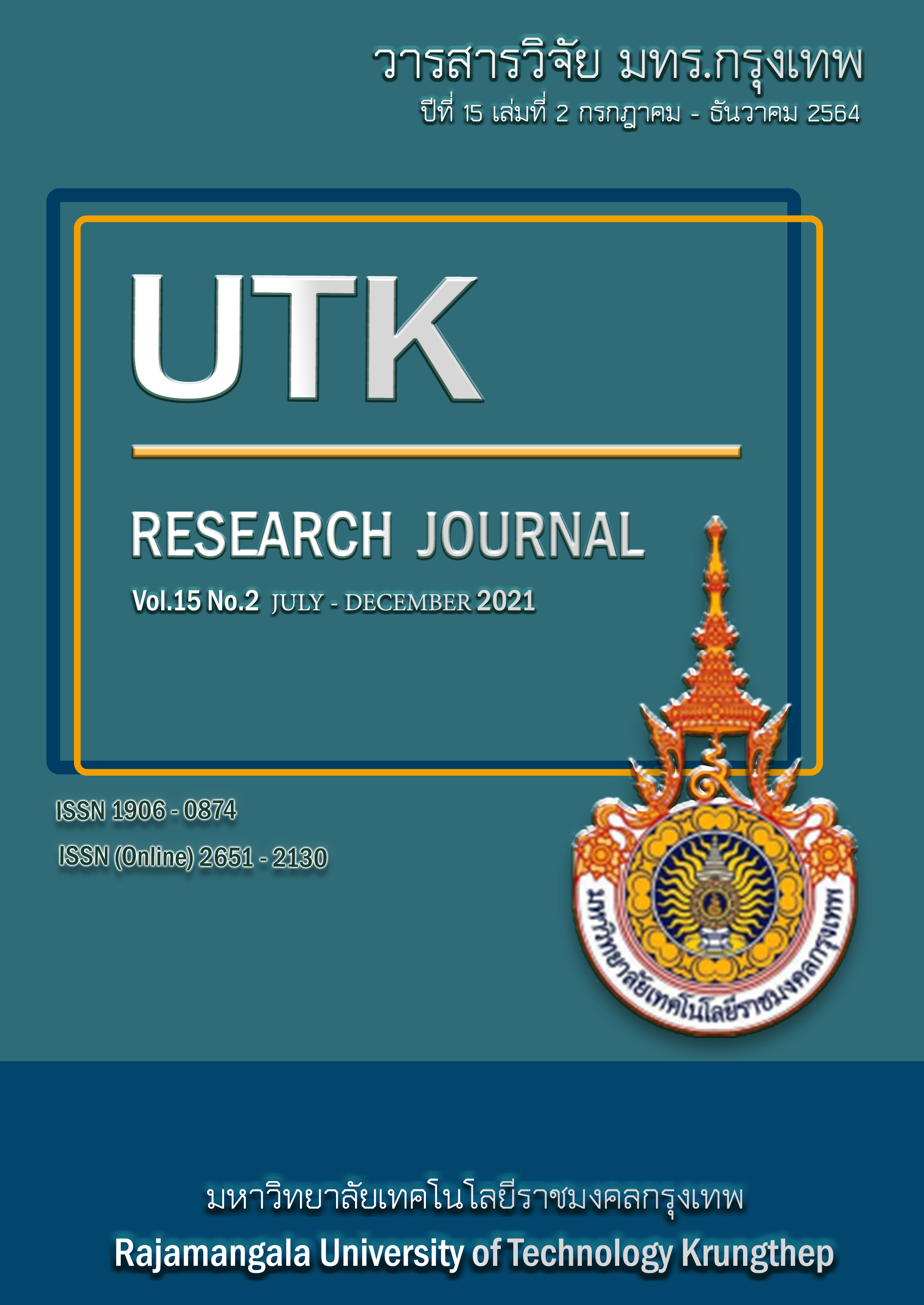อิทธิพลของสารตกแต่งสำเร็จกันยับชนิดต่าง ๆ ต่อสมบัติของผ้ามัสลิน
คำสำคัญ:
การตกแต่งสำเร็จ, สารกันยับ, ผ้ามัสลิน, ฝ้ายบทคัดย่อ
งานวิจัยนี้เป็นการเคลือบสารลงบนผ้ามัสลินเพื่อให้ผ้ามีสมบัติทนต่อการยับและช่วยลดการรีดผ้าหลังการซักลงหลังการใช้งาน ภาวะที่เหมาะสมในการเคลือบผ้ามัสลินด้วยสารไดเมทิลออลไดไฮดรอกซีเอทิลีนยูเรีย (KNITTEX® FEL) คือ อุณหภูมิ 160 องศาเซลเซียส นาน 60 วินาที การใช้สารกันยับชนิดไดไฮดรอกซีเอทิลีน-ยูเรียที่ปราศจากฟอร์มาลดีไฮด์ (KNITTEX® FF) มีความคงทนต่อการยับดีที่สุด อัตราการดูดซึมน้ำบนพื้นผิวผ้ามัสลินที่ตกแต่งด้วยสารกันยับช้ากว่าผ้ามัสลินที่ไม่ผ่านการตกแต่งเล็กน้อย นอกจากนั้น ความกระด้างของผ้ามัสลินก่อนและหลังการตกแต่งกันยับมีค่าใกล้เคียงกัน
เอกสารอ้างอิง
MasterClass [Internet]. San Francisco: Fabric 101: What Is Muslin? How to Use and Care for Muslin; c2021 [updated 2020 Nov 8; cited 2021 Mar 26]. Available from: https://www.masterclass.com/articles/fabric-101-what-is-muslin-how-to-use-and-care-formuslin#what-is-muslin
Yahya C, Muhammet A, Yildiray T, et al. Effect of Wrinkle Resistance Finish on Cotton Fabric Properties. Indian Journal of Fibre & Textile Research. 2009; 34: 183-186.
Tusif MQ, Mahmood N, Amin N, et al. Impact of Various Wrinkle Free Finishes on Wrinkle Recovery Property of Cotton Fabric under Different Variables. J Textil Sci Eng. 2014; 4: 1-5. DOI: 10.4172/2165-8064.1000160.
Rui W, and Huawu L. Wrinkle-Resistance Property of Cotton Fabric Treated by Chitosan and Epoxy-Silicone Micro-Emulsion. Advanced Materials Research. 2011; 331: 382-385. DOI:10.4028/www.scientific.net/AMR.331.382.
Lixia H, Lin X, Guang, Y. Chitosan Application in Textile Processing. Current Trends in Fashion Technology & Textile Engineering. 2018; 4(2): 1-3. DOI: 10.19080/CTFTTE.2018.04.555635.
Jian L, Bijia W, Xiaomei X et al. Green Finishing of Cotton Fabrics Using a Xylitol-Extended Citric acid Cross-linking System on a Pilot Scale. ACS Sustainable Chemistry & Engineering. 2016; 4(3): 1131-1138. DOI: 10.1021/acssuschemeng.5b01213.
Xu W, Li Y. Cotton Fabric Strength Loss from Treatment with Polycarboxylic Acids for Durable Press Performance. Textil Res J. 2000; 70(11): 597-961. DOI: 10.1177/004051750007001104.
Kuzuhara A, Hori T. Reducing Wrinkle Formation in Wool with 2-Iminothiorane Hydrochloride. Textil Res J. 2002; 72(4): 285-289. DOI: 10.1177/0040517502072 00402.
Nawshin F, Abu N, Ahsanul H, et al. Comparative Enactment of Formaldehyde free and Formaldehyde based Cross-linkers on Cotton Woven Fabrics. Tekstilec. 2017; 60(2): 107-115. DOI: 10.14502/Tekstilec2017.60.107-115
Nilgün Ö, Arif Taner Ö, Gamze SM, et al. Influence of Yarn and Fabric Construction Parameters on Drape and Bending Behavior of Cotton Woven Fabrics. TEKSTİL ve KONFEKSİYON. 2014; 24(2): 169-179.
On-na H, Chi-wai K. Effect of CO2 Laser Treatment on The Fabric hand of Cotton and Cotton/Polyester Blended Fabric. Polymers. 2017; 9(11): 1-12. DOI:10.3390/polym9110609.
Sunay O, Esra K, Behcet B. Comparison of Bending, Drapability and Crease Recovery Behaviors of Woven Fabrics Produced from Polyester Fibers Having Different Cross-sectional Shapes. Textile Research Journal. 2010; 80(12): 1180-1190. DOI:10.1177/0040517509355351.
ดาวน์โหลด
เผยแพร่แล้ว
รูปแบบการอ้างอิง
ฉบับ
ประเภทบทความ
สัญญาอนุญาต
กองบรรณาธิการวารสารวิชาการ มหาวิทยาลัยเทคโนโลยีราชมงคลกรุงเทพ มีความยินดีที่จะรับบทความจากอาจารย์ นักวิจัย นักวิชาการทั้งภายในและภายนอกมหาวิทยาลัย ในสาขาวิชาวิทยาศาสตร์และเทคโนโลยี ได้แก่ สาขาวิชาวิทยาศาสตร์ วิศวกรรมศาสตร์ และสาขาอื่นๆ ที่เกี่ยวข้อง รวมถึงสาขาต่างๆ ที่มีการบูรณาการข้ามศาสตร์ที่เกี่ยวข้องวิทยาศาสตร์และเทคโนโลยี ที่เขียนเป็นภาษาไทยหรือภาษาอังกฤษ ซึ่งผลงานวิชาการที่ส่งมาขอตีพิมพ์ต้องไม่เคยเผยแพร่ในสิ่งพิมพ์อื่นใดมาก่อน และต้องไม่อยู่ในระหว่างการพิจารณาของวารสารอื่น
การละเมิดลิขสิทธิ์ถือเป็นความรับผิดชอบของผู้ส่งบทความโดยตรง บทความที่ได้รับการตีพิมพ์ต้องผ่านการพิจารณากลั่นกรองคุณภาพจากผู้ทรงคุณวุฒิและได้รับความเห็นชอบจากกองบรรณาธิการ
ข้อความที่ปรากฏอยู่ในแต่ละบทความที่ตีพิมพ์ในวารสารวิชาการเล่มนี้ เป็นความคิดเห็นส่วนตัวของผู้เขียนแต่ละท่าน ไม่เกี่ยวข้องกับมหาวิทยาลัยเทคโนโลยีราชมงคลกรุงเทพแต่อย่างใด ความรับผิดชอบด้านเนื้อหาและการตรวจร่างบทความแต่ละบทความเป็นของผู้เขียนแต่ละท่าน หากมีความผิดพลาดใดๆ ผู้เขียนแต่ละท่านจะต้องรับผิดชอบบทความของตนเองแต่ผู้เดียว
กองบรรณาธิการขอสงวนสิทธิ์มิให้นำเนื้อหา หรือข้อคิดเห็นใดๆ ของบทความในวารสารวิชาการ มหาวิทยาลัยเทคโนโลยีราชมงคลกรุงเทพ ไปเผยแพร่ก่อนได้รับอนุญาตจากกองบรรณาธิการ อย่างเป็นลายลักษณ์อักษร ผลงานที่ได้รับการตีพิมพ์ถือเป็นลิขสิทธิ์ของวารสาร






